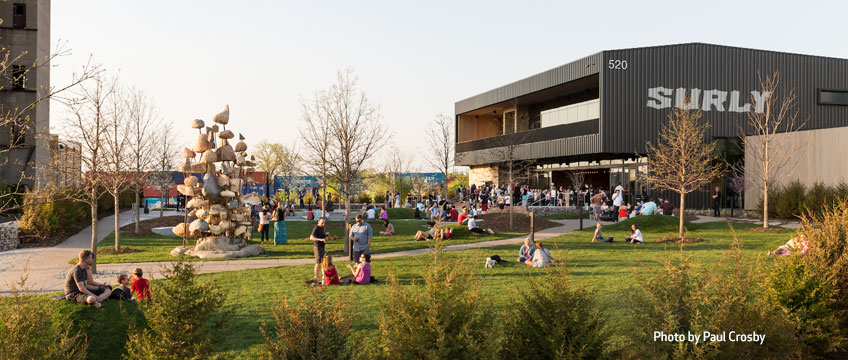Creative ferment and a Minneapolis architecture firm help Surly Brewing Company reimagine the beer hall in a modern form
By Joel Hoekstra
Craft beers are known for their unique character, and few are more confrontational than those made by Surly Brewing Company. The Minnesota-based beer producer, which sold its first keg in 2006, has always prided itself on non-mass appeal—branding its brews with edgy names such as Furious, Cynic, and Devil’s Work and generally exuding an against-the-grain attitude. (It’s fitting that the company’s founder, Omar Ansari, got his start in the industrial abrasives business.)
But that go-it-alone posture has won Surly the respect of beer snobs and college kids alike, and if the crowds flocking to its new Twin Cities destination brewery this summer are any indication, the company’s style has widespread popularity. Since December, Surly has provided tours of its gleaming new production facility to hundreds and served up cold beer, beef brisket, and hot pretzels to thousands more in its beer hall. A sumptuous, 100-seat fine-dining room welcomed its first guests in May, and bookings for the facility’s private-event space have begun to ramp up. This summer, when the freshly landscaped beer garden, replete with fire pits and an eye-popping sculpture by Minneapolis artist Zoran Mojsilov, finally opened up, the frivolity sloshed outside.
At Surly Brewing MSP, you can eat, drink, and even buy a Surly souvenir at the in-house gift store. But HGA Architects and Engineers’ Steven Dwyer, AIA, the lead designer of the project, points out that all this activity revolves around a factory. “The brew house is the heart of the whole facility,” he says. “That’s where we started.”
In fact, the project began with a change in Minnesota law. In 2011, at Surly’s urging, state legislators amended a Prohibition-era statute that barred production breweries from selling their product onsite. A host of brewpubs with ancillary taprooms popped up across the Twin Cities and even outstate. But Surly had its eye on something bigger: a production facility that could produce 185,000 barrels (more than 5.7 million gallons) of beer annually and would draw international tourists as well as local beer enthusiasts.
Surly purchased an eight-acre site in an industrial park on the Minneapolis–St. Paul border. Formerly home to a potato-processing plant, the land required environmental cleanup, but the plot had several virtues: It was in the heart of the cities, with proximity to the University of Minnesota’s Twin Cities campus and light-rail transit; it had easy access to local highways for receiving supplies and shipping product; and it drew water from the same aquifer as Surly’s original facility in Brooklyn Center, ensuring that the beer brewed at the new site would taste the same.
At 50,000 square feet, Surly’s new facility is more than twice the size of its old brew house. Its exterior is clad in corrugated steel panel and western red cedar, and its low-slung flat rooflines make no effort to look old or Bavarian. “The building was designed to be a lean, mean brewing machine,” says Dwyer. “We didn’t want anything that was hokey or romantic or reminiscent of something Surly had never been. We wanted the feel to be industrial, to be tied to the purpose of the building.”
Visitors pass a large fire ring and a water feature—“visual and auditory appetizers,” Dwyer explains—before entering the building. Once inside the doors, they encounter a glass wall enclosing six gleaming fermentation silos. The funnels of the holding tanks hang in rows from the ceiling, creating a gravity-defying architectural pattern that will grow only more impressive as additional tanks are added in years to come. “We call it the beer temple,” says Dwyer. It’s the first act in a series of experiences that the architect describes as “theatrical.” With each new room, the drama unfolds.
Down a short but wide hallway is the main act: Behind a nearly three-story glass wall comparable to a proscenium lies the German-engineered brew house with a lauter tun as the centerpiece. Blindingly shiny, the enormous kettle resembles a set for a play with no dialogue. The action inside the cauldron is invisible, yet the pipes, levers, ladders, and gauges that barnacle its surface fuel the imagination. Visitors stare in anticipation, visibly stirring when the brew master appears to turn a knob or check a temperature control.
Just out of sight there’s a canning facility and keg room. High ceilings, clerestory windows, and tubular skylight devices make these areas seem light and airy—a contrast with many industrial spaces. Overall, the design anticipates expansion, with several walls designated for removal as production grows. “We spent a lot of time touring other brewing facilities and learning how to streamline production,” says Surly’s director of brewing operations, Todd Haug. “The brewing community is surprisingly collaborative. People were willing to share.”
Beer not earmarked for off sale flows to the Surly taproom, a space filled with dozens of tables made of reclaimed elm. A large metal hoop light, similar to those found in old German beer halls, hovers over the space, but the design is clean and modern. “We tried to keep the vocabulary pretty simple,” says Dwyer of the materials and furnishings. Black metal and cedar are used throughout the beer hall. Red, gold, and black—the Surly brand colors—predominate.
“It’s kind of in-your-face,” Linda Haug, Surly’s hospitality director, says of the design. “But it’s elegant and industrial.”
“It pairs well with our beer: It’s polarizing,” adds her husband, Todd. “Not everyone likes it. And that’s OK. Because we feel great about it.”
SURLY BREWING MSP
Location: Minneapolis, Minnesota
Client: Surly Brewing Company
Architect: HGA Architects and Engineers
hga.com
Principal-in-charge: Mia Blanchett, AIA
Project lead designer: Steven Dwyer, AIA
Project architect: Rob Good, AIA
Landscape architect: HGA Architects and Engineers
Owner’s representative: Tegra Group
General contractor: McGough Construction
Size: 50,000 square feet
Completion: December 2014
Photographers: Paul Crosby; Corey Gaffer



